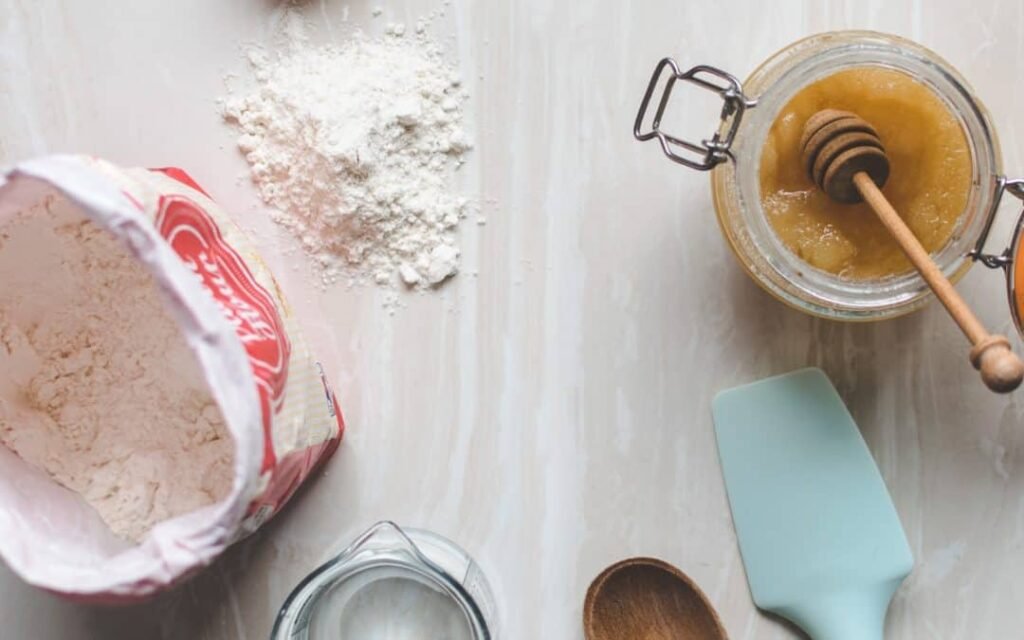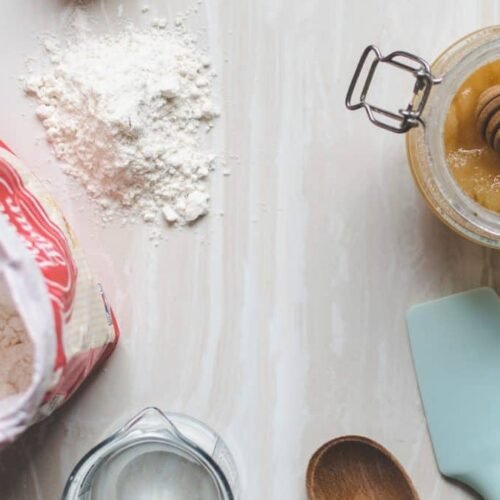Have you ever heard of lecithin?
It’s an important ingredient in many food products, and it has a wide range of uses.
Lecithin is a natural emulsifier that helps to bind ingredients together, making them easier to mix and preventing them from separating.
It also acts as an antioxidant, preserving the freshness of foods for longer periods.
Unfortunately, not everyone can tolerate lecithin due to allergies or dietary restrictions.
If you find yourself in this situation, don’t worry – there are plenty of great substitutes for lecithin that can help you achieve the same results without compromising on taste or texture.
In this article, I’ll be exploring six of the best alternatives to lecithin so that you can continue cooking delicious dishes without worrying about potential health risks.
What is Lecithin?

Lecithin is a type of phospholipid that occurs naturally in plants and animals.
It is an important component of cell membranes, and is found in egg yolk, soybeans, sunflower seeds, peanuts and other sources.
Lecithin has a yellow-brownish color and is available as granules or as liquid.
It has a distinct odor that some people find unpleasant.
The most common use for lecithin is as an emulsifier which helps combine oil and water components into one homogeneous mixture; it’s commonly used in food products like chocolate, margarine, baking mixes and salad dressings.
It can also be added to beverages such as milkshakes or smoothies to improve texture without adding flavor; it works by preventing separation of the ingredients during storage or consumption.
Lecithin can also be used to reduce foaming when frying foods such as tempura batter or deep-frying doughnuts.
The 6 Best Substitutes For Lecithin
Lecithin is a natural emulsifier used in many recipes.
But what do you do if it’s not available?
Here are six great substitutes for lecithin that will help you get the same results:
1 – Sunflower Lecithin

Sunflower lecithin is an increasingly popular cooking ingredient, and it’s easy to see why!
It serves as an emulsifier and helps bind ingredients together.
This makes it ideal for applications like sauces, dressings, fat-replacement products, vegan milks, cake mixes, etc.
Sunflower lecithin is also incredibly versatile compared to other forms of lecithin because it works at a broader range of temperatures—you don’t have to worry about melting points or degassing too much during beating or stirring.
Furthermore, most sunflower lecithin comes from organic sources which increases its appeal in the culinary world.
When would you use sunflower lecithin instead of regular lecithin?
In situations where there are strict temperature requirements – meaning produce that must stand up against higher temperatures – sunflower lecithin is the better choice due to its increased stability across both hot and cold environments.
Additionally, if a recipe calls for margarine or some other evenly dispersed oil source but can be made dairy free and vegan with vegan alternatives then this could be another potential situation when it’s best to reach for sunflower lecithin.
2 – Guar Gum
Guar gum is a white powder that comes from guar beans, a species of legume native to India.
This versatile ingredient is gaining popularity in the culinary world for its thickening and stabilizing capabilities.
It can be used as an egg or gluten substitute, to improve texture and add body to sauces and dressings, or even baked goods while also adding fiber.
While both lecithin and guar glue are emulsifiers, they are quite different ingredients. Lecithin will create more of an oily feel on your tongue when used in cooking, making it great for creating mayonnaise-based sauces like aioli.
Guar gum has almost no taste at all but adds more thickness than lecithin; making it perfect for creating creamier bases like ice cream.
Overall, guar gum can be considered more of an effective thickening agent than lecithin if you’re looking for texture improvements outside of just adding oiliness that comes with using lecithin.
3 – Egg Yolk

A true kitchen staple, egg yolk is an incredibly versatile ingredient often used in a variety of dishes.
Whether you’re making custard, mousse, or mayonnaise, egg yolks are perfect for binding wet ingredients together and creating creamy sauces.
The fats in the yolks help to give any dish a delightfully smooth texture without adding oils or other thickeners like flour.
Egg yolks have great flavor too–they’re rich, delicious and mild enough not to overpower what they’re added to.
Plus they add color—especially when you separate the whites from their yellow centers!
And while there are some big health benefits to eating eggs regularly (including vitamin B12 and omega-3 fatty acids), these aren’t why people love using egg yolks so much in cooking; it’s all about the taste and texture this humble little ingredient can provide.
When should you use egg yolk instead of lecithin?
Whenever you’re looking for a richer flavor or creamier texture, as well as something that will bind wet ingredients but won’t add extra oiliness.
Egg Yoak is your best bet!
4 – Xanthan Gum

Xanthan Gum is quite a versatile ingredient and one of the most popular for cooks.
It’s often used as an easy-to-use thickening agent, creating structure and binding ingredients in dishes such as soups, sauces, gravies, dressings, desserts and more.
Xanthan Gum is super convenient to use because it only requires a tiny amount to create great results – usually just a teaspoon – so you don’t need much to get the right texture or flavor.
This means you can go on just adding more if needed until you’re satisfied with its effects.
A benefit of using Xanthan over lecithin is that it doesn’t spoil easily due to its excellent stability at room temperature.
It also has greater heat tolerance compared to other thickeners and gums which makes it ideal for hot sauces or dishes containing high temperatures.
Additionally, unlike lecithin which already contains fat molecules like oil or butter (which can give your food an off taste), Xanthan gum works by suspending solids together without any added fats being required making it perfect for healthier recipes like vegan foods or lower-fat options.
5 – Mustard

Mustard is an incredibly versatile and popular ingredient found in many dishes all over the world.
Perhaps its popularity can be attributed to its unique flavor—the combination of tangy, spicy, and savory makes it a great condiment or seasoning.
Mustard also has some advantages over ingredients like lecithin; while lecithin adds texture and emulsifies liquids together, mustard has the same capability with the added bonus of adding flavor.
In fact, mustard often creates a more powerful emulsion than lecithin does!
Additionally, when you want more depth of flavor in a dish as opposed to simple cohesion between ingredients, then mustard is definitely your best bet.
Overall, from baking to cooking meats to making dressings and sauces—mustard’s characteristics make it perfect for rounding out any dish with complex flavors and an extra punch.
6 – Agar Agar

Agar Agar has quickly become a popular ingredient in cooking due to its many desirable qualities.
It’s a vegan, fat-free and gluten-free alternative to gelatin, making it a great choice for those who have dietary restrictions.
It also creates an interesting texture when added to recipes such as ice cream or jam.
While agar agar is often used interchangeably with lecithin in some recipes, it actually has different uses depending on what type of recipe you are making.
For example, while both can act as thickeners in liquids like sauces and syrups, agar agar is far more effective at thickening solid foods like jams and jellies than lecithin which is better suited for light foams or dressings.
Conclusion
In conclusion, lecithin is an important ingredient in many food products, but not everyone can tolerate it due to allergies or dietary restrictions.
Thankfully, there are several great substitutes for lecithin that can help you achieve the same results.
These include sunflower lecithin, guar gum, egg yolk, xanthan gum, mustard, and agar agar.
Each of these alternatives has its own unique properties that can help you create delicious recipes without compromising on taste or texture.
However, it’s important to understand the differences between them to make sure you get the desired results.

The 6 Best Substitutes For Lecithin
Ingredients
- Sunflower Lecithin
- Guar Gum
- Egg Yolk
- Xanthan Gum
- Mustard
- Agar Agar
Instructions
- Pick your favorite substitute from the list above.
- Follow cooking directions for your selected substitute with the proper ratio of ingredients.
Hi, I'm Benjamin. I love cooking, long walks, and my girlfriend! Here you’ll find simple and delicious recipes that you can make in 30 minutes or less.

